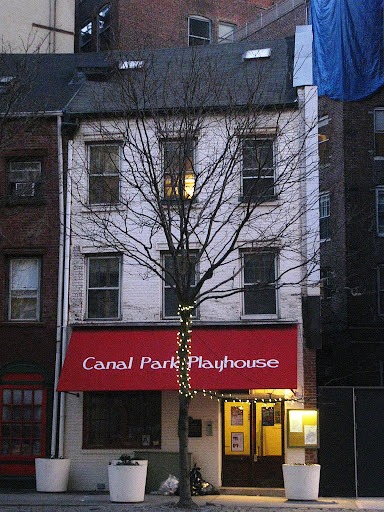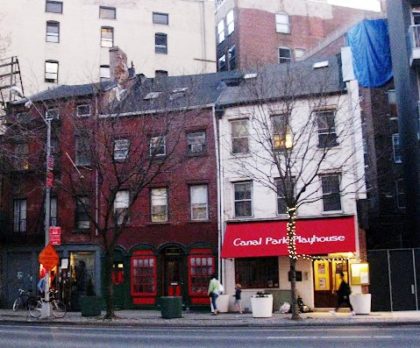The History of 508 Canal
 Tom Miller, who writes about the history of Manhattan buildings at Daytonian in Manhattan, has allowed Tribeca Citizen to create a database of his Tribeca posts. If you enjoy these, and you will, then you should definitely check out his website, which also has write-ups about buildings all over the island. And don’t miss his book, Seeking New York: The Stories Behind the Historic Architecture of Manhattan—One Building at a Time.
Tom Miller, who writes about the history of Manhattan buildings at Daytonian in Manhattan, has allowed Tribeca Citizen to create a database of his Tribeca posts. If you enjoy these, and you will, then you should definitely check out his website, which also has write-ups about buildings all over the island. And don’t miss his book, Seeking New York: The Stories Behind the Historic Architecture of Manhattan—One Building at a Time.
··································
 In the 1820s, merchant tailor John George Rohr was an industrious man. A German immigrant, he recognized that the rapid development of the Canal Street area—just a few years earlier worthless pastureland called Lispenard’s Meadows—would be more profitable than the apparel business.
In the 1820s, merchant tailor John George Rohr was an industrious man. A German immigrant, he recognized that the rapid development of the Canal Street area—just a few years earlier worthless pastureland called Lispenard’s Meadows—would be more profitable than the apparel business.
In 1819, the “canal” down the center of Canal Street (actually, it was more accurately a drainage trench) had been covered over to create a sewer and Canal Street suddenly became an expansive, 100-foot wide thoroughfare. The major east-west road quickly developed with mixed-use structures; most with commercial space on the street level and living quarters above.
Around 1820 Rohr began building near-matching two-and-a-half-story brick buildings along Greenwich Street on leased Lispenard land, just north of Canal Street. Most likely a relative, also named John Rohr, who was a mason and builder was responsible for their construction. By 1826, the Rohrs’ had erected a string of 16 Federal-style houses on Greenwich Street—five south of Canal Street and eleven north. That year they added two more on the south side of Canal Street, between Greenwich and Washington Streets, numbered 239 and 241. (Decades later, in 1860, the houses would be renumbered 506 and 508.)
Like the rest of Rohr’s houses, No. 241 would have a store in the first floor and living quarters above. The new homes, however, were three stories tall and Rohr included an unusual cast-iron shop front. The shallow, paneled pilasters supported cast iron arches that mimicked the arched doorway.
 Originally, highly unusual cast-iron arches graced the shop level of No. 508, like those that survive next door.
Originally, highly unusual cast-iron arches graced the shop level of No. 508, like those that survive next door.
··································
Rohr rented the house at No. 241 to Moses S. Phillips. Three years later James H. Greenfield opened his china store here and would remain for about three years. In the meantime, Roderick Sedgwick, a merchant doing business at 39 Front Street, leased the upper floors.
In 1840 John G. Rohr sold No. 241 to Frenchman Joseph Batby, a 36-year old “ivory-turner.” Ten years later Batby and his family—wife Sarah and their four children—were still here. Anthony, their son who was now 16-years old, was already earning a living as a jeweler.
In 1850 Batby was renting rooms to other families as well. Another French immigrant, George H. Denot and his wife, Maria, were here; John and Catherine Flaherty; and the family of Irish-born stonecutter James Sinnot: his wife Mary, their daughter Catherine and Mary’s mother, Mary Kennedy.
Joseph Batby’s heirs sold the property in 1870. Henry Wellbrook and his family were living upstairs here in 1872. On Thursday afternoon, May 9 burglars broke into the apartment while the family was out. The New York Times reported that “The place was ransacked, and $300 worth of wearing apparel and jewelry taken.” For a family renting small rooms the theft was no doubt devastating. The $300 loss would amount to about $5,000 today.
Matthew Thompson purchased the property in 1882 and built a one-story adjoining workshop to the rear that covered the back lot. Upstairs the tenant list continued to be a broad mix. Among the renters at the turn of the century was retired police officer Peter Kelly.
Whether Joseph Thompson was a relative of Matthew Thompson is unclear, but by 1908 he and James J. Moran ran their plumbing company, Thompson & Moran, from the store space. Thompson lived here as well and in 1914 he got himself into a bit of trouble.
The 50-year old plumber had been living on a small motor boat off the north shore of Long Island for about a week in August, perhaps on a sort of vacation. Late on the night of August 14, he gave the residents of Northport a scare. The New York Times reported the following day that “Shortly after midnight this morning he aroused the village by running through the streets, shouting at the top of his voice, ‘Get up, the British are coming.’ The police think he is suffering from sunstroke.”
In 1941, the ground floor was converted to a restaurant and in doing so the wonderful cast-iron shop front was removed. A brick front replaced the cast iron, thoughtfully laid in Flemish bond.
Throughout the 20th century the little brick structure was home to a variety of businesses. Then, in 1980, Kipp Osborne and his wife, Margot, purchased the house, rearing their daughter here. For a period they ran “Osborne and Osborne” from street level, designing and building custom-made hardwood furniture. Marketed as “furniture-as-art,” each piece was dated, signed and numbered.
Kipp Osborne then renovated the street level into the Canal Park Playhouse, a theater-caberet. The upstairs was converted to The Canal Park Inn, a bed and breakfast, which opened in 2011. The four rooms (each named for a former owner or resident) were decorated with a nod to the history of the structure.
Despite the unfortunate loss of the rare and early cast-iron façade at the first floor, the 1826 house retains most of its architectural integrity, resulting in what the Landmarks Preservation Commission calls “a striking reminder of the initial phase of the development of New York City in the years of the early republic.”
··································
Photo credits from top: Alice Lum (2).












